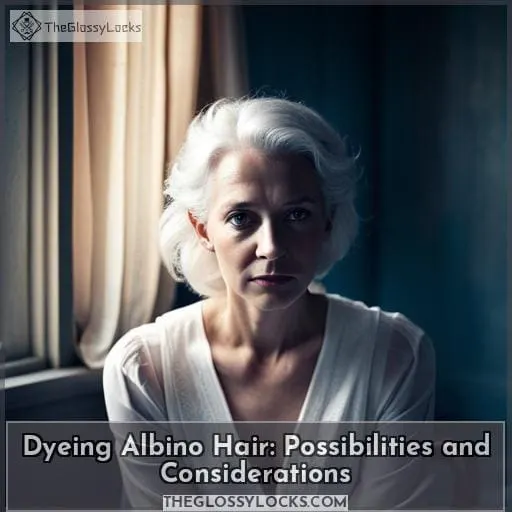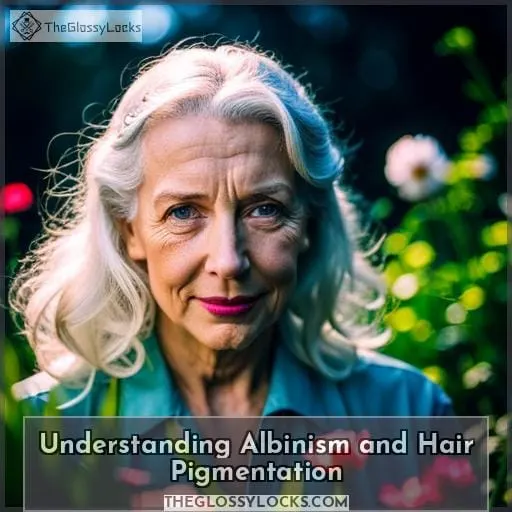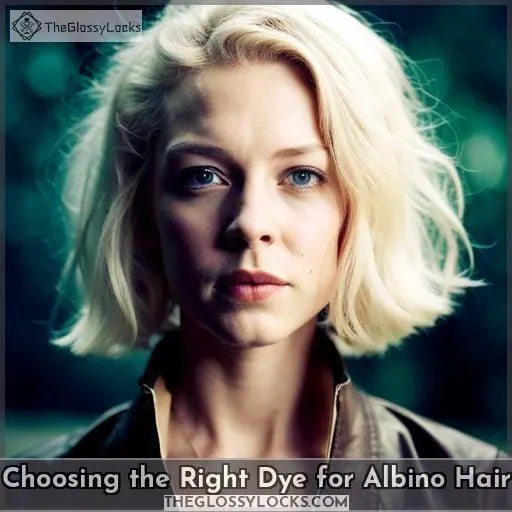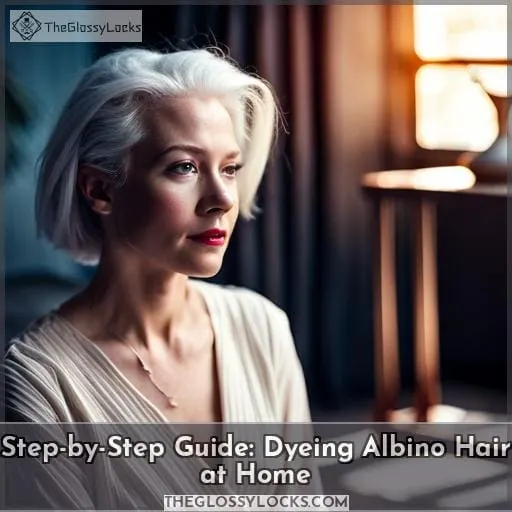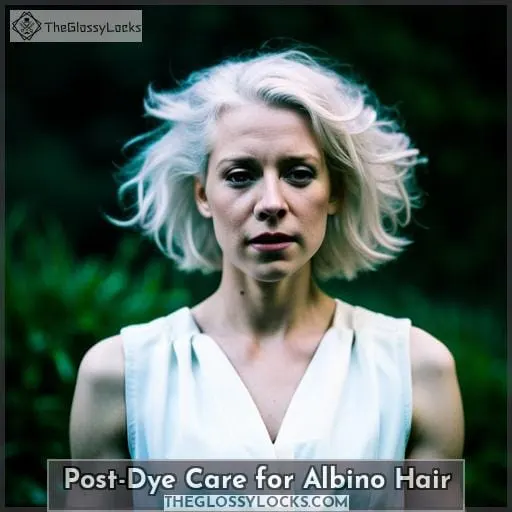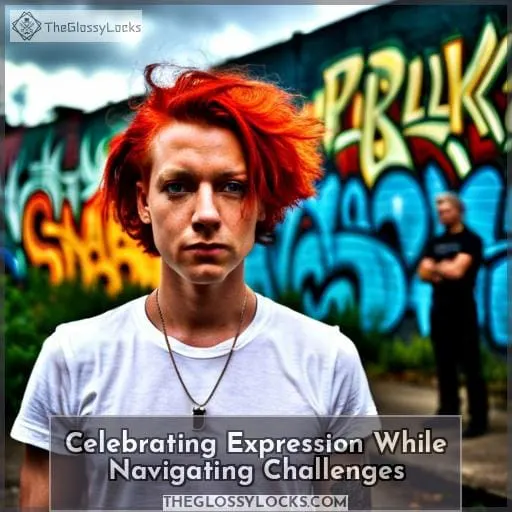This site is supported by our readers. We may earn a commission, at no cost to you, if you purchase through links.
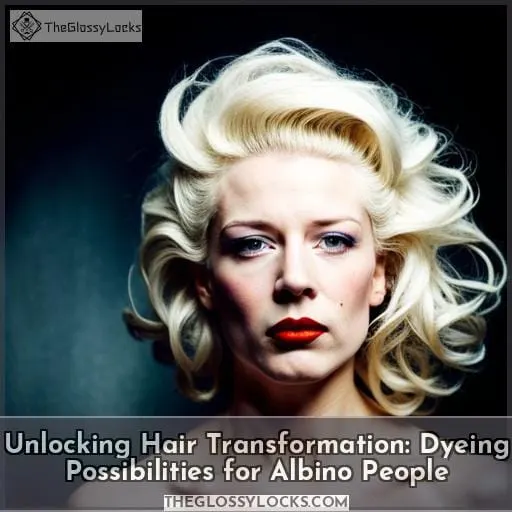
Albinism has been deemed one of the rarest conditions known to mankind, affecting approximately one in every 17-20K individuals worldwide. It’s characterized by an absence or decrease in pigmentation of skin, eyes, and most importantly for this article, hair too! As melanin production can be limited due to Albinism, many wonder if they should even bother attempting home dyeing at all given its potential risks and effects on already fragile strands.
Let’s explore what it takes for Albino people to safely take part in expressing themselves through color without compromising their health along the way.
Table Of Contents
- Key Takeaways
- Dyeing Albino Hair: Possibilities and Considerations
- Understanding Albinism and Hair Pigmentation
- Choosing the Right Dye for Albino Hair
- Step-by-Step Guide: Dyeing Albino Hair at Home
- Ensuring Safe and Vibrant Results
- Post-Dye Care for Albino Hair
- Professional Assistance Vs. DIY Dyeing
- Celebrating Expression While Navigating Challenges
- Conclusion
Key Takeaways
- Albinism affects the melanin in the skin, eyes, and hair, resulting in albino hair lacking in melanin and being notably soft.
- Dyeing albino hair presents unique challenges, including sensitivity to chemicals in hair dye.
- Safe dyeing options for albino hair include henna dye, temporary dyes, and semi-permanent dyes.
- Prioritizing patch tests, using recommended techniques, and post-dye care are important for successfully dyeing albino hair at home.
Dyeing Albino Hair: Possibilities and Considerations
Albinism is a genetic condition that affects the production of melanin in the eyes, skin, and hair. As such, albino hair has distinct characteristics and sensitivities to chemicals that must be taken into consideration when discussing the possibilities of dyeing it.
Unique Characteristics of Albino Hair
You may need to take extra care when considering hair treatments due to the unique characteristics of pigment-lacking tresses. Albino hair tends to have a softer texture than other types of locks and lacks melanin, which can affect styling options.
Understanding the challenges associated with dyeing albino hair requires knowledge about pigmentation as well as special techniques for ensuring the best results during the dyeing process. Haircare products should be chosen carefully to avoid damage or irritating sensitive skin caused by a lack of melanin on the scalp and follicles.
With proper research, caution, and professional guidance from an experienced colorist, individuals with albinism can enjoy more vibrant locks while still protecting their delicate strands from harm.
Sensitivity to Chemicals
Be aware that your delicate strands may be extra sensitive to harsh chemicals used in hair dye. When considering the options for coloring albino hair, it’s important to take into account possible chemical sensitivities as well as potential allergic reactions or skin irritation.
For those with albinism, permanent dyes aren’t generally recommended due to their higher risk of damaging follicles and irritating the scalp. Instead, semi-permanent or temporary dyes are better choices. They provide vibrant color without having a strong impact on your delicate locks and can help manage sensitivity issues more effectively than harsher alternatives.
Henna dye is another excellent choice since it doesn’t contain any chemical components that could irritate your scalp or cause an allergic reaction.
Understanding Albinism and Hair Pigmentation
It’s important to understand the genetic condition of albinism and how it affects melanin production in order to safely dye your hair. Albinism is a disorder that results in reduced pigmentation, causing variations in eye, skin, and hair color.
There are two types of albinism: Oculocutaneous and Ocular albinism, each with different characteristics. Melanin production determines the amount of pigment present in our strands, resulting in white or pale shades for those affected by this disorder due to its absence or low levels.
Hair sensitivity caused by the lack of pigmentation can damage follicles when exposed to harsh chemicals found in permanent dyes. This makes temporary options preferable, as they minimize potential irritation risks while still providing striking colors such as neons, pastels, platinum silver, and reds, for instance.
Henna is also an option since it doesn’t contain any chemical compounds. This allows individuals with albinism more freedom when styling their locks without worrying about damaging effects from stronger bleaches and dyes used widely today.
Understanding the genetics behind albinism helps us better manage expectations regarding coloring processes while making sure we take all safety measures needed prior to applying products directly onto our scalp.
Choosing the Right Dye for Albino Hair
When choosing dye for albino hair, several factors must be taken into account. Optimal results can usually be achieved by selecting temporary or semi-permanent dyes and considering the unique sensitivities of albino hair due to its lack of melanin.
Factors for Color Choice
When deciding on a color for your hair, consider the pigment in your strands and how it will interact with the dye. Color psychology, fashion trends, skin undertones, and cultural influences can all affect which hue works best.
Hair accessories like clips or headbands may also influence the result. For albino people dyeing their hair, sensitive skin should be taken into account when choosing chemical-based dyes; seeking professional assistance is often recommended to achieve desired results without damaging follicles or causing an allergic reaction.
Optimal Dye Types
You can choose from temporary, semi-permanent, and permanent dyes to bring out the beauty of your unique hair color. Consider selecting henna hair dye or natural oils for a chemical-free approach that is gentle on sensitive scalps.
For longer-lasting results with minimal irritation, try using semi-permanent dyes – just be sure to get professional advice first! Deep conditioning and avoiding heat are also recommended for maximum color longevity.
Step-by-Step Guide: Dyeing Albino Hair at Home
If you are an albino looking to dye your hair at home, there is a process that should be followed. Preparing the hair for dyeing and applying the dye correctly are essential steps in achieving desired results while avoiding damage or irritation.
It is important to take time to prepare properly and understand how different products work on albino hair before beginning this project.
Preparing Your Hair for Dyeing
Before you start dyeing your unique hair, preparation is key to achieving the desired results. Protect colored hair and scalp with a pre-color protective product like a barrier cream or oil. Check color compatibility between the current hue and the chosen shade for the best results; avoid irritation by patch testing before application.
Consider the chemical sensitivity of albino individuals when selecting temporary dyes, as permanent ones can damage follicles and irritate the skin.
Applying the Dye
Mix the dye with conditioner and test a strand to make sure you get the desired color before applying it. When dyeing albino hair, consider techniques such as sectioning, saturating, and heating up. These techniques require research and understanding of your own hair sensitivity levels.
Choose colors that suit your skin tone, such as neons or pastels, while patch testing for any allergic reactions beforehand. To prepare your tresses for better absorption, use a low pH shampoo. Avoid conditioning during the application process.
After application is complete, rinse in cold water followed by a deep conditioning treatment to ensure the best results in terms of adhesion and longevity.
Ensuring Safe and Vibrant Results
It is important to take precautions before dyeing albino hair, such as conducting patch tests and managing allergic reactions. To ensure safe and vibrant results for those with albinism, it is essential to be mindful of the potential risks associated with chemical-based colorants.
Conducting Patch Tests
It’s essential to conduct a patch test before dyeing albino hair, as it can be more sensitive and prone to damage than typical hair. The process entails applying a small amount of dye behind the ear or on the inner elbow for 24 hours.
This allows time for any potential chemical reactions and allergic responses that may occur when using permanent dyes on white or platinum blonde locks. Test results should be interpreted carefully. Lighter-colored eyebrows are also vulnerable to color shade changes due to their sensitivity.
Hair and scalp damage could result from the use of these products if not done properly.
Managing Allergic Reactions
If you’re experiencing an allergic reaction to the dye, it’s important to take action quickly. To prevent further damage and skin sensitivity, allergy management is key. Patch testing can identify any chemical sensitivities before starting a hair coloring process.
It’s also essential to use ammonia-free dyes with a pH balance that will maintain moisture retention and minimize hair follicle damage. Lastly, avoiding harsh heat styling post-dyeing helps retain vibrant color for longer while preventing more scalp irritation due to its low melanin content.
Post-Dye Care for Albino Hair
After dyeing albino hair, maintenance is essential to keep the color vibrant and healthy. Deep conditioning treatments are recommended for post-dye care, along with using sulfate-free products and avoiding heat styling.
Such practices will help preserve the longevity of your dyed hair while nourishing it back to its natural state.
Deep Conditioning for Maintenance
To maintain your vibrant hue, give your hair the love it deserves with a deep conditioning treatment. Repairing damage caused by home dyeing or chemical use is key for albino individuals who wish to keep their color looking fresh and healthy.
Moisturizing techniques restore hair elasticity and prevent split ends, while protein treatments can help strengthen strands, protecting against future damage. Deep conditioning should be done regularly, depending on hair type. It is important to use products specifically designed for colored tresses that are free of sulfates or harsh chemicals.
With proper maintenance, including regular deep conditionings, and careful selection of dyes and other products tailored to albinism sensitivities, beautiful results can be achieved with minimal irritation.
Sulfate-Free Products and Heat Styling
For optimal hair health, using sulfate-free products and avoiding heat styling will help keep your vibrant albino hair color for longer. When dyeing albino strands, take precautions with heat styling tools to minimize damage.
- Protect delicate strands with a thermal protectant before using hot tools.
- Consider alternatives like air drying or roller sets that cause less breakage than blow dryers or flat irons.
- Use gentle brushes when detangling to avoid ripping out fragile hairs.
Sulfate-free shampoos also help preserve the natural oils of the scalp and extend color longevity by not stripping away vital moisture from DIY dyed locks.
Professional Assistance Vs. DIY Dyeing
When considering dyeing albino hair, it is important to be aware of the benefits and drawbacks of both professional assistance and DIY methods. Professional colorists are knowledgeable in techniques that minimize potential damage, while exploring natural alternatives such as henna dyes can provide vibrant results with less skin irritation.
Expert Colorist Consultation
Consulting a professional colorist is recommended to ensure successful dyeing of albino hair with minimal damage. Colorists possess expertise in analyzing pigment interaction and providing personalized recommendations for safety.
They also ensure long-lasting effects of bold or pastel colors on light or dark brown hair.
Understanding the unique nature of albinism allows professionals to adjust their techniques according to an individual’s needs.
Proper consultation can result in vibrant hues without compromising scalp health or texture integrity.
Exploring Natural Dye Alternatives
Discovering natural alternatives to chemical-based hair dyes can open up a world of colorful possibilities for you. Henna is one such option, providing benefits such as fewer chemicals and less damage than permanent box dyes or professional salon treatments.
Herbal options like henna are also safe to use on albino hair without causing irritation due to the lack of pigment in their locks.
If DIY recipes aren’t your style, there are plenty of chemical-free alternatives available that provide all the same color choices as conventional dye products while avoiding damaging ingredients.
Celebrating Expression While Navigating Challenges
Dyeing hair can be a liberating and expressive experience for individuals with albinism, but it requires careful consideration to maintain healthy hair and scalp. It is important to research various options, evaluate potential risks, select suitable products, and get expert consultation in order to achieve desired results without causing damage.
Liberating Aspects of Hair Dyeing
Unleash your inner rainbow with hair dyeing – express yourself in vibrant, popping colors! Whether it’s electric pink or ginger hair you’re looking for, the power of change through color can be a confidence boost.
The psychology of certain hues and their impact on social perceptions helps to make personal empowerment even more powerful. From leave-in conditioners to heat styling products, there is so much potential for self-expression with hair dyeing.
With professional guidance or DIY options available, you’ll find that liberation awaits around every corner when it comes to expressing yourself through hair color!
Maintaining Healthy Hair and Scalp
Maintaining healthy hair and scalp is essential for successful albino dyeing. You’ll want to make sure your locks stay strong and vibrant!
Scalp care should include regular cleansing, moisturizing techniques, pH balance maintenance, massaging benefits, and anti-dandruff solutions.
To keep strands from becoming dry or brittle after coloring treatments, use a mild shampoo tailored to sensitive scalps. A hydrating conditioner will help restore moisture levels in the hair shafts while protecting against future damage caused by styling tools or environmental stressors.
Gentle massage with natural oils can improve circulation flow, aiding in the absorption of nutrients into your tresses. It also increases sebum production on the scalp, which helps maintain a healthy environment that prevents dandruff flare-ups.
With proper precautionary measures taken beforehand, albinos can enjoy bold new looks without compromising their delicate manes!
Conclusion
Achieving a bold and beautiful look can be a liberating experience for albino individuals, yet they must consider the unique characteristics of albino hair when dyeing it. With careful color selection, patch testing, and professional guidance, albino people can safely embrace the transformative power of dyeing their hair.
This approach helps them avoid potential scalp and hair damage due to the lack of melanin.
By conducting thoughtful research and understanding the sensitivities of albino hair, individuals can achieve a vibrant, healthy, and enduring hair color. Exploring the possibilities of albino hair dyeing allows us to proudly celebrate our unique expression and embrace the joy that comes with it.

